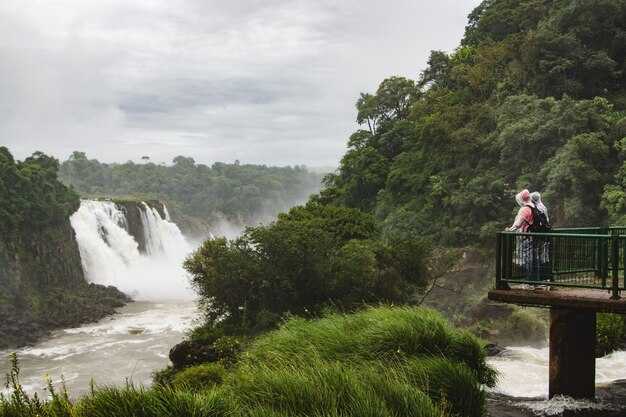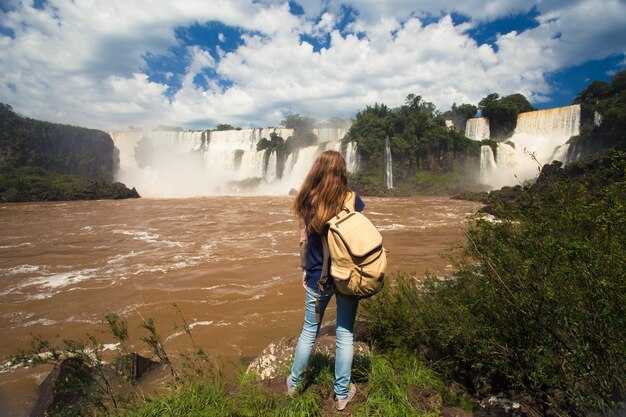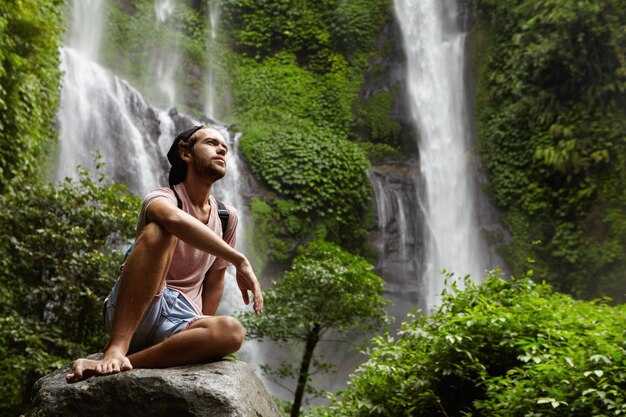advice: arrive before 9 am to enjoy cooler temperatures and clearer viewpoints on the Brazilian side. If you have arrived, head straight to the upper decks to catch the spray without long lines. Plan your route to maximize short walks between shaded spots and bring a light backpack with sunscreen and a microfiber towel.
Find your base: The belmond Hotel das Cataratas on the Brazilian side offers easy access to the park entry. If you lean toward budget options, frequent hostels around Foz do Iguaçu keep daily costs reasonable. michaela, an australian traveler, says a flexible plan and conversation with staff unlock quiet paths after rain. bring an amount for local taxis or shuttle buses, and reserve a couple of hours for a relaxed morning walk.
What to wear and pack: Wear sturdy shoes with grip for slippery stones. dont forget a lightweight rain jacket; the spray from the falls sticks to everything. Pack a compact poncho, bottled water, and a small power bank for photos. A daily plan helps you hit viewpoints in the best light, especially as temperatures rise.
Plan your route: Start at the main Brazilian circuit and work your way to the Garganta do Diabo overlook. Use the park shuttle to hop between trailheads, especially in peak heat. Look for wildlife, like toucans and coatis, along shaded stretches. A well-timed visit in the morning or late afternoon yields better lighting for photos.
Practical tips: Bring protection for cameras; the spray can fog lenses. dont rely on data connectivity in the park; download offline maps beforehand. The amount of walking is moderate but stairs add up; take breaks and hydrate. Consider a late-afternoon viewpoint, when temperatures drop again and mist creates rainbows.
Best Time to Visit the Brazilian Side for Garganta do Diabo Viewpoints
Plan your visit for May or September and start before 9 a.m. to catch Garganta do Diabo viewpoints on the Brazilian side with soft light and thinner crowds.
In these dry-season months, the wide catwalk stays dry, the air is comfortable, and visibility is best for photography. If you come in summer, be ready for higher humidity and occasional showers that heighten the mist and create dramatic portraits; the views remain powerful, especially in early morning light or late afternoon when the land and forest contrast most.
weve found that morning visits pay off: over the years, travelers have learned to optimize timing by starting early; weekdays are generally calmer; backpackers and local guests mix with day-trippers on weekends, but the quieter hours are still present. To simplify logistics, use rideshare from town to the park entrance, a reliable means to avoid parking hassles. On-site facilities provide a simple lunch option at the gate, but for a fuller meal you can purchase in town or at a nearby mall after your visit. wifi coverage is strongest near the main plaza; along the main catwalks it can be spotty, so download offline maps in advance. At the gate you obtain a map and can purchase tickets online to start smoothly. The Garganta route on the Brazilian side is wide and well-maintained, with viewpoints that place you between the spray and the forest land; some overlook on the opposite bank offer a different perspective if you plan a separate day trip to the Argentine side.
Timing and viewpoints
- Start early: aim for 7:00–9:00 a.m. to beat crowds and catch the best light.
- Prefer May or September for lower rainfall and comfortable temperatures, with strong water flow still present.
- Choose weekdays when possible; weekends draw backpackers and families, increasing crowding at key lookouts.
- Check the weather and park alerts the night before; morning mists can affect visibility if you start too late.
Practical planning

- Wear sturdy shoes for a wide, well-maintained path that remains mostly flat but can be slick after rain; plan for tiny spray droplets on skin and glasses.
- Pack light rain gear, sunscreen, and a small backpack; dorm-style hostels around town offer budget options if you’re traveling with a group.
- Purchase tickets online in advance to start your day smoothly; at the gate you can obtain a map and you’ll see coverage updates on-site.
- Use rideshare means to reach the entrance; it’s a common, cost-effective option for solo travelers and groups.
- Be mindful of wifi coverage: stay offline with maps if the signal is weak on the trails; download the route beforehand.
- Consider adding a second day to explore the Argentine side for a fuller variety of viewpoints between the two countries.
Getting There: From Foz do Iguaçu to the Brazilian Park Entrance
Book a private transfer or use a reliable taxi to reach the Brazilian Park Entrance quickly. From Foz do Iguaçu to the entrance, expect about 25–30 km of road, 30–45 minutes in light traffic; peak times can stretch it to 60 minutes. If you arrive via the IGU airport or other area airports, a pre-booked shuttle or taxi offers door-to-gate service, saving you stops and backtracking. Here’s a practical approach that keeps everyone on track.
Two solid ride options: private transfer or public bus
Option A: Private transfer. A driver waits in the arrivals hall at IGU or at your hotel and delivers you directly to the Park Entrance. Expect to pay around R$80–120 one way, depending on your hotel location and traffic; it’s better to pay a bit more for reliability, especially with kids or a lot of gear. If you’re traveling with others, the per-person cost drops and the space helps you pack everything you need. Passengers appreciate the convenience after travel, and the driver can stop for a quick photo along the road if you ask.
Option B: City bus. From downtown Foz, Bus 120 Cataratas runs roughly every 30–40 minutes and stops at the park gate. The ride takes about 60–75 minutes and costs around R$5–7. Board at the Terminal de Ônibus or at major urban stops; you’ll avoid parking hassles but share the ride with other passengers. If you missed the first bus, there are later departures–check the current timetable at your hotel or the terminal; plan to arrive early to beat the heat and crowds. Instead, if you’re on a tight budget, this is a better choice for the day.
There, crossing to the argentinean side is optional but can be a good complement in a full day. If you decide to cross, bring your passport and be prepared for customs checks; plan a separate entry and exit window, and note that afternoon temperatures can rise a few Fahrenheit degrees. If you want to explore ciudad neighborhoods on the other side, do it after you finish here and return for the Brazilian gates.
Practical packing and planning: pack light, leave bulky bags at the hotel if possible, and carry a small water bottle; the weather on the Brazilian side is sunny most days. In summer, temperatures often peak in the 80s or 90s Fahrenheit, so sunscreen, a hat, and a light jacket for cooler mornings help. The entry plaza is a short walk from the bus stop, but you’ll do more walking inside the park beyond the gate. Here, the shortest walk from the gate to the main outlooks takes about 15–25 minutes. If you’re touring with kids, pace yourself and add rests; everyone benefits from a relaxed rhythm. Create a simple itinerary list to guide your day, then review it at the bus stop to learn about current conditions and time windows, and leave some buffer for unexpected stops with others who share tips and plans.
Finally, a quick note to add to your plan: begin at the entrance, buy tickets, and consider the electric train for faster access to the most famous viewpoints on the Brazilian side. The vistas are amazing, and mornings offer softer light for photos. If you want a special day that blends park scenery with city culture, this route is worth the effort. The plan is straightforward, practical, and designed for smooth travel; by following these steps, you’ll avoid delays and enjoy the falls with less stress.
Ticketing, Parking, and Entrance Logistics for Garganta do Diabo
Purchase tickets online in advance and select an earlier time slot to make the visit easier and to avoid crowded queues during peak months.
Ticketing options on the official site include single-entry passes and combination experiences. Price varies by age and country of residence, with exchange rates available at checkout. The site accepts cards and cash, and the counter at the entrance can process exchanges for nearby networks if necessary.
Parking near the entrance is limited. Lot A sits closest to the Brazil-side entry, while Lot B is about a kilometre away along a walkable path. Expect hourly rates, with payment possible at the booth or via a mobile app. Plan for 1–2 hours if you want to explore both circuits and the lookout points without rushing.
Entrance logistics place you at a controlled gateway for Garganta do Diabo. Gates open early and close in the late afternoon; bring only essential belongings to speed checks, as staff conduct standard security inspections. Have your requirements ready–photo IDs, tickets, and any permitted tech–while keeping belongings compact to avoid intrusive lines. Use the main walkway and circuit route to reach the famous lookout without backtracking.
Local guidance from avid visitors adds value: Silva, a guide from Barroso, suggests starting at the lower circuit lookout to catch the best light, then following the walkways along the main circuit. The route is walkable for most guests, with a comfortable kilometre-scale stretch between lookouts. After the falls, many travelers enjoy a relaxed dinner nearby before departing for the airports or hotels in the country.
| Kategória | Odporúčanie | Poznámky |
| Ticketing | Book online; choose morning slot; print or save on phone | Price varies by country and age; exchange available at counter |
| Parking | Use Lot A near entry; Lot B is a short kilometre walk | Pay hourly; app or gate; plan 1–2 hours |
| Entrance | Arrive early; carry only essentials | Security checks are standard; lookouts along the walkway |
| Tipy | Bring water, wear walkable shoes, consider a dinner stop after | Avid photographers will appreciate early light; Silva recommends route via lower circuit |
The Main Trail: Distances, Prime Viewpoints, and Walking Time to Devil’s Throat
Start at the entrance and walk directly toward Garganta do Diabo; this one-way segment conveniently sets you up for the final platform and definitely feels efficient for most visitors.
Hlavný chodník k Diablovmu hrdlu má dĺžku približne 2 km jedným smerom, pričom pohodlné tempo vonku umožňuje chôdzu približne 40 – 50 minút. Ak plánujete postáť pri každej vyhliadke a urobiť množstvo fotografií, vyčleňte si 60 – 90 minút na celý prístup k finálnej platforme.
Hlavné hľadiská a pešia vzdialenosť
Po približne 0,7–0,9 km sa z prvého výhľadu naskytá široký pohľad na dolné kaskády a hmlu, ktorá pri jasnom svetle vytvára dúhy. Pokračovaním ďalších 0,5–0,6 km sa dostanete na plošinu uprostred chodníka so širšou panorámou cez rieku a zalesnené brehy.
Posledná platforma Garganta do Diabo sa nachádza približne na 2. kilometri a ponúka najvyšší a najvzrušujúcejší pohľad zblízka na kaskádu v tvare podkovy. Toto je ten vysoký, dramatický moment, ktorý všetci fotografujú, s rozstrekom vo vánku a dramatickým rozsahom, vďaka ktorému sa zvyšok trasy oplatí.
Po ceste nájdete miesta na sedenie a tienisté miesta na odpočinok, vďaka čomu je prechádzka pohodlnejšia pre rodiny a pre každého, kto si dáva pozor na teplo alebo slnko. V prípade potrieb mobility sa v informačnom centre informujte o prístupe na horné terasy s pomocou výťahu; niektoré časti ponúkajú rampový prístup alebo alternatívne trasy na hlavnú palubu.
Či už prídete ráno alebo popoludní, tieň a sedenie vám pomôžu udržať si stabilné tempo. Z vyhliadok uvidíte rieku, ako sa rozprestiera do šírky na severozápade, a okolitú džungľu, pričom počas pokojnejších hodín je možné pozorovať divokú zver. Hľadajte španielske a portugalské nápisy označujúce vzdialenosti a majte mapy po ruke, aby ste si podrobne naplánovali konkrétne zastávky. Ak sa cítite energicky, každá vyhliadka sa stáva outdoorovou aktivitou, čím sa samotná cesta mení na kompaktný výlet.
Tento plán si môžete prispôsobiť svojmu tempu a záujmom. Ak sa zdržiavate v tejto oblasti, okolité reštaurácie ponúkajú rýchle občerstvenie pred alebo po prechádzke; ak sa ponáhľate, môžete trasu skrátiť otočením sa po prvom alebo druhom vyhliadkovom bode a stále si zachytiť hlavné zaujímavosti.
Čo si obliecť a čo si zbaliť na prechádzky dažďovým pralesom
Začnite s rýchloschnúcimi nohavicami alebo šortkami a priedušnou, nepremokavou bundou; noste pevnú obuv s uzavretou špičkou a dobrou priľnavosťou. Ak plánujete presun na bicykli alebo krátku jazdu medzi miestami, vyberte si obuv s bezpečným uchytením a prineste si rukavice.
Vrstvenie pomáha: základná vrstva odvádzajúca vlhkosť, ľahká stredná vrstva a kompaktná nepremokavá bunda. To, čo si oblečiete, závisí od predpovede a vašej tolerancie na vlhkosť; rána sú chladnejšie a vo vyšších nadmorských výškach môžu teploty rýchlo stúpať. Dážď môže prísť veľmi rýchlo, takže buďte pripravení.
Čo si zbaliť
Od vchodu si vezmite 8-12 litrový denný batoh s vodotesným vakom na elektroniku. Zbaľte si fľašu s nápojom alebo hydratačný systém; zamerajte sa na aspoň 1,5 litra na 60-90 minútovú prechádzku.
Ochrana pred slnkom: klobúk, slnečné okuliare, opaľovací krém. Ochrana pred hmyzom: repelent. Ochrana pred dažďom: pončo alebo ľahká nepremokavá bunda, ak váš batoh nemá obal.
Vodotesné puzdro na telefón alebo fotoaparát; náhradné batérie; energetická tyčinka.
termálne kúpele sú neďaleko, takže si prineste uterák, ak je v pláne po prechádzke navštíviť termálne kúpele.
Noste hotovosť v pesách na hraničné miesta; väčšina nákupov v parku akceptuje karty, ale niektoré stánky sa spoliehajú na hotovosť. Čo sa týka ubytovania a stravy, v blízkosti sa nachádzajú hotely a reštaurácie; plánujte podľa toho.
Národní a medzinárodní návštevníci si môžu zabezpečiť transfery a taxíky pred vchodom; otváracie hodiny sa líšia podľa sezóny. Väčšina okruhov trvá 60-90 minút; v niektoré dni je rušno, preto si nechajte pár minút navyše na miesta s fotografiami a vyhliadkové body.
Tipy na fotografovanie: Zaznamenávanie vodopádov Iguazu z brazílskej strany
Zamierte do oblasti Porto za prvého svetla, aby ste zachytili ostrú hmlu a teplé svetlo na skokanskej platforme; majte pripravený rýchly objektív a často utierajte vlhkosť z filtra, aby ste zachovali ostré hrany hmly. Osvojte si strelecké návyky: kontrolujte svetlo každých pár minút a prejdite scénu predtým, ako sa rozhodnete, aby ste nezmeškali prchavú dúhu.
Na brazílskej strane sú chodníky obmedzené v uhloch pohľadu, takže si naplánujte 60-90 minútový okruh, aby ste prešli hlavné vyhliadky a vnútorné chodníky v korunách stromov. Skontrolujte aktualizované otváracie hodiny parku a odchody, aby ste si prispôsobili svoj plán pokojnejším chvíľam; dátum a počasie ovplyvňujú odrazy a celkové podmienky sa môžu rýchlo zmeniť. Ak kombinujete výlety do misií, koordinujte ich starostlivo, ale buďte flexibilní, aby ste sa vyhli rušivým davom. Použite to ako základ pre plánovanie vašej trasy, aby ste maximalizovali slnečné svetlo na každej vyhliadke.
Vnútri parku môžu byť davy ľudí pri hlavných platformách rušivé; snažte sa fotiť tesne po výbuchu gejzíru a potom vstúpte do sviežich okrajov pre intímne zábery blízko vody. Dávajte pozor na divokú zver pozdĺž okrajov, vrátane mačiek. Parkovanie je pohodlné v blízkosti vchodu, ale vráťte sa späť predtým, ako dav ľudí v kyvadlovej doprave dosiahne vrchol; nájdete tu prekvapivo tiché miesta pozdĺž bočných chodníkov a budete radi, že ste si obuli pohodlnú obuv na ochranu nôh.
Najlepšie časy a vyhliadkové miesta
Výborné svetlo nastáva po svitaní; z vyhliadky Salto môžete pri stúpaní slnka zachytiť dúhu. Z niektorých vyhliadok uvidíte obrovské výhľady na vodnú clonu, potom sa presuniete po promenáde, aby ste zarámovali vodopády, keď sprej prenikne cez les. Pre mimoriadne dramatické siluety zostaňte až do neskorého rána a opäť neskoro popoludní, keď sa tiene tiahnu pozdĺž kaskády. Zvážte druhý prechod vnútorným okruhom, aby ste zachytili vodné stuhy cez stromy. Celkovo si vyberte niekoľko kľúčových miest a použite ľahký statív, aby ste sa vyhli kývaniu na promenáde, pričom vždy nechajte priestor na prenasledovanie meniaceho sa spreja.
Výbava, nastavenia a plánovanie

Používajte širokouhlý objektív (16 – 35 mm) na panorámy a stredný teleobjektív (70 – 200 mm) na zachytenie detailov vodných plôch a zahmlených aur. Nastavte expozíciu okolo f/8 – f/11 a ISO 100 – 200; pre hodvábnu vodu vyskúšajte 1 – 2 sekundy so stabilným statívom, alebo prepnite na vyššie rýchlosti uzávierky, ak vietor zmení smer striekajúcej vody. Polarizačný filter pomáha redukovať odlesky v jasných dňoch a filter neutrálnej hustoty predlžuje vaše dlhé expozície. Snímajte do formátu RAW a používajte aplikácie na mapovanie trás, kontrolu parkovania a sledovanie časových okien a odchodov. Ak zostanete nablízku, 2 – 3 hodinové okno postačí na pokojné tempo; pri výletoch s rodinou udržujte úseky krátke a umožnite luxusný pobyt v blízkosti. Ak skombinujete cestovanie za misiami alebo spojíte výlety, nájdete viac scenérií a menej čakania. Na záver rýchlo skontrolujte nohy: ustúpte, aby ste posúdili mierku a ochránili svoju výbavu pred striekajúcou vodou.



Komentáre